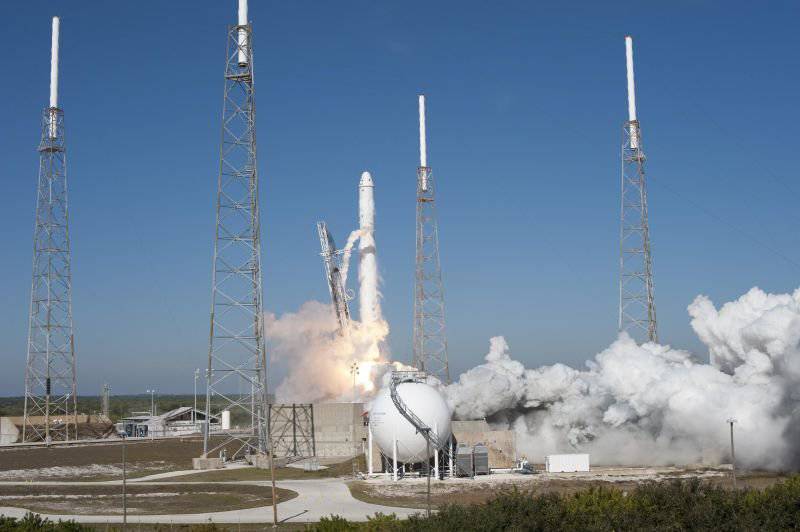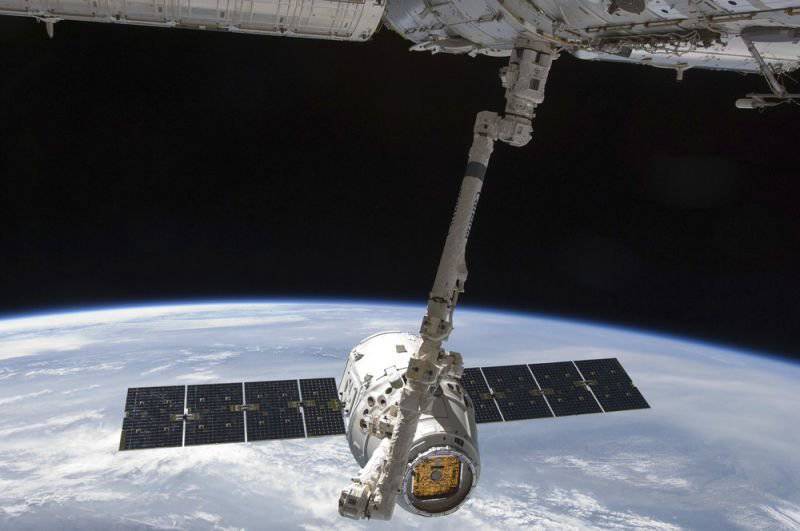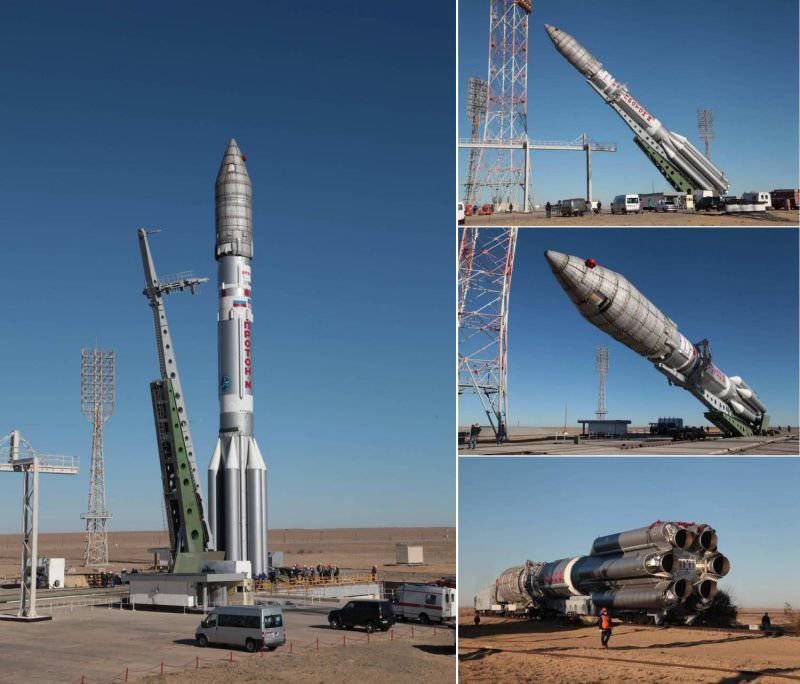"Proton-M" waiting for serious competition with the American rocket "Falcon 9"
The first space commercial ship in this program was the SpaceX-launched Dragon, developed by SpaceX. In May 2012, he successfully delivered kg of payloads to the 500. Especially for this spacecraft, the Falcon launch vehicle was created. 4 December 2013 of the year from the cosmodrome located on Cape Canaveral, this rocket successfully launched a communications satellite into orbit. And although the start was made only with the third attempt, the satellite was successfully launched into Earth orbit. The main thing in this event is that the launch of the American Falcon missile cost 30 million dollars cheaper than using the Russian Protons for this purpose.
Initially, the launch of the Falcon 9 rocket with the SES 8 telecommunications satellite on board was scheduled to take place on November 25 of the year 2013, but during the preparation of the rocket for launch, various technical problems were noted several times, because of which the launch was postponed. The launch of the launch vehicle was postponed to Thanksgiving Day - a holiday celebrated in the US on November 28. But this time, in preparation for the launch, there was a failure: the automation stopped the rocket launch after ignition, as the engine power of the rocket did not increase fast enough. The Falcon 9 rocket was removed from the launch pad and sent to the hangar for the engine inspection procedure. The next launch attempt was scheduled for December 2, but the launch was postponed by the 4 number for additional verification. As a result, December 4 launch still took place and ended successfully.

Rocket Falcon 9 is a two-stage ship, which was developed by a private company from California, SpaceX. The company's founder is the American billionaire Elon Musk. Specialists of the company say that the rocket created by them is the cheapest means of launching various spacecraft into space at the moment. The cost of launching an American rocket ranges from 56 to 77 million dollars. At the same time, the cost of launching the Russian Proton into space is 100 million dollars, and the European launch vehicle Ariane 5 is 200 million dollars.
The Falcon 9 (“9 Falcon”) is an American disposable launch vehicle of the Falcon family, developed by SpaceX. The first launch of this rocket took place on 4 June 2010 of the year. Currently, various configuration options are offered for this launch vehicle, which differ in mass of the payload delivered to orbit. Falcon rockets are able to deliver cargoes in the 10,4-32 tonnes range and into a geo-transfer orbit (GPO) in the 4,7-19,5 tonnes range to a low reference orbit (LEO). The launch cost depends on the mass and volume of the payload (for the Falcon 9 rocket, these values are 10 and 4,7 t, respectively). The payload container has dimensions in the range of the 3,6-5,2 meter. The Falcon 9 rocket can also be used to launch a commercial manned spacecraft (PKA) Dragon and its cargo counterpart, designed to deliver cargo to the ISS. These ships are also developed by SpaceX.
The basic version of the launch vehicle consists of 2-x steps. The first stage of the rocket uses 9 LRE Merlin 1C, and the second stage - 1 LRE Merlin Vacuum, which is a modification of the same engine, adapted to work in a vacuum. Just like the Falcon 1 launch vehicle, the Falcon 9 rocket launch sequence assumes that it is possible to stop the launch process in case of detection of problems with the rocket systems and engines before launch. If any malfunctions are detected, the launching process is interrupted and the oxidizer and fuel are pumped out of the rocket. Due to this, for both stages of the launch vehicle, it is possible to reuse them and conduct full-fledged bench tests before flying into space.

Another blow to the Russian space program could be the refusal of Americans to deliver astronauts with the help of the Russian Soyuz spacecraft. According to specialists, every place for an astronaut aboard a Russian ship costs the US budget 65 million dollars. Therefore, the US space agency expects to completely abandon the Roscosmos services by 2017. It is assumed that by this date private spacecraft will deliver into space not only payloads, but also astronauts. In will already have ships Dragon and Cygnus. In addition, 2 spacecraft is being prepared by Boeing and Sierra Nevada.
Booster "Proton-M"
The Russian Proton-M launch vehicle is a modernized version of the Proton-K launch vehicle; it has the best performance, energy-mass and environmental characteristics. The first launch of this rocket with the Briz-M upper stage took place on April 7 of the year 2001. Proton-M is a three-stage launch vehicle with a mass of about 702 tons. The use of enlarged head fairings, including 5 meters in diameter, in the Proton-M rocket allows for more than 2 fold increase in volume for placing payload on board. The increase in the volume of the head fairing of the rocket allows, among other things, to use on the Proton-M some promising booster blocks.
The main objective of the missile modernization was to replace its SU - control system, which was developed as early as 1960-ies and morally obsolete, including on the element base. As a result of the modernization, the Proton-M rocket received a new SU, which is built on the basis of the on-board digital computing complex. The main elements of this system were pre-flight tests on other launch vehicles that have already been successfully operated. The use of a new control system has significantly improved the technical and operational performance of the rocket. For example, it was possible to achieve an improvement in the consumption rate of the onboard fuel reserve due to its more complete production.

An important task, which was implemented with the rocket designed, was to reduce the area of fields that are allocated for the fall of the spent first stages of the launch vehicle. It should be noted that for Russia, which carries out launches from the cosmodrome leased from Kazakhstan, this is a very urgent problem. The reduction of the area of the fall fields of the spent first stages of the rocket was realized with the help of a controlled descent of the accelerator of the 1 th stage to a limited area.
It is worth noting that reducing the size of the fields falling rocket stages, in addition to reducing the rent, also allows you to simplify the task of collecting and subsequent disposal of the remnants of the 1-th stage of the launch vehicle. In addition, elements of the first stage of the rocket fall to the ground already almost “clean” - the cyclogram of the first stage of the rocket rocket engine is built in such a way that it provides full production of components from the tanks of the rocket, which leads to an increase in the environmental performance of the Proton-M.
In addition, the use of a new Briz-M upper stage in the launch vehicle, which operates on such fuel components as unsymmetrical dimethylhydrazine and nitrogen tetraxide, has made it possible to improve the payload indicator, which can be put into geostationary orbit - up to 3,7 t, and Georetransfer orbit - more than 6 tons.
Information sources
http://www.vesti.ru/doc.html?id=1164795
http://www.federalspace.ru/465
http://ria.ru/space/20131204/981732999.html
http://ru.wikipedia.org/wiki/Falcon_9
Information